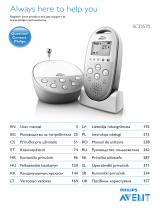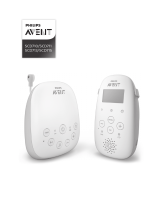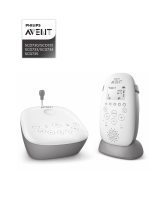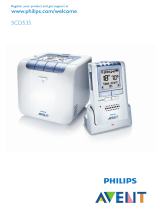
20
C Caution:
InEcoMaxmode,theparentunitreceives
feedbackfromthebabyunitwithadelay.When
yourbabymakesasound,thebabyunitrsthas
toreactivateradiotransmissionbeforeitcan
sendfeedbacktotheparentunit.
7.3.1 Please note the following:
• Before you select the Eco Max mode in the
menu of the parent unit, make sure that the
parent unit and baby unit are within operating
range, see section ‘Operating range’ in chapter
‘Using the baby monitor’. In Eco Max mode
you do not receive feedback when the parent
unit is out of range of the baby unit. You can
check the link by pressing any button on the
parent unit.
• If there is no radio transmission from the baby
unit to the parent unit in Eco Max mode, the
sound level lights are off. The sound level lights
go on when the baby unit reactivates radio
transmission because the baby makes a sound
above the selected sensitivity level.
• If you want to operate the baby monitor in
Eco Max mode, make sure the microphone
sensitivity is set between level 1 and level 3.
If the microphone sensitivity is set at level
4, the baby unit does not switch off radio
transmission in Eco Max mode.
7.3.2 Activating Eco Max mode
1 Select ‘Eco Max’ in the menu with the + and -
buttons and press OK to conrm.
2 When the display shows ‘Turn On’, press OK
to switch on the Eco Max mode.
3 The warning message ‘!No alert if out of
range, OK?’ appears on the display. Press OK
to conrm.
D
Note:
The warning message scrolls across the display
twice. If you do not press OK, the parent
unit leaves the menu and the Eco Max mode
remains off.
3 Press OK to conrm the setting.
7.2.1 Sensitivity levels and indications
Icon Sensitivity Description
highest Hear everything from your
baby. The speaker of the parent
unit is continuously on.
high Hear all sounds from soft
babbling and louder. If your
baby does not make any
sound, the speaker of the
parent unit is off.
medium Hear sounds from soft cries
and louder. If your baby makes
softer sounds, the speaker of
the parent unit does not go on.
low The speaker of the parent unit
only goes on if the baby makes
loud sounds, for instance
because it is crying.
7.3 Eco Max mode
This baby monitor has Smart Eco that
automatically reduces the DECT signal from the
baby unit as the distance between parent unit
and baby unit becomes shorter. By reducing radio
transmission, it helps to save energy.
If you want to save even more energy and to stop
radio transmission, activate the Eco Max mode
in the menu of the parent unit. In this mode, the
DECT signal of the baby unit is switched off. As
soon as the baby makes a sound, the DECT signal
of the baby unit automatically switches on again.




















 Avent SCD570/00 Manual de utilizare
Avent SCD570/00 Manual de utilizare
 Avent SCD506/52 Manual de utilizare
Avent SCD506/52 Manual de utilizare
 Avent SCD711/52 Manual de utilizare
Avent SCD711/52 Manual de utilizare
 Avent SCD731/52 Manual de utilizare
Avent SCD731/52 Manual de utilizare
 Philips AVENT SCD535/00 Manual de utilizare
Philips AVENT SCD535/00 Manual de utilizare
 TinyLove 130680E001 Tiny Dreamer Musical 1-in-3 Projector Manual de utilizare
TinyLove 130680E001 Tiny Dreamer Musical 1-in-3 Projector Manual de utilizare
 Miniland digitalk luxe Ghid de inițiere rapidă
Miniland digitalk luxe Ghid de inițiere rapidă